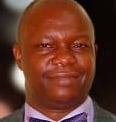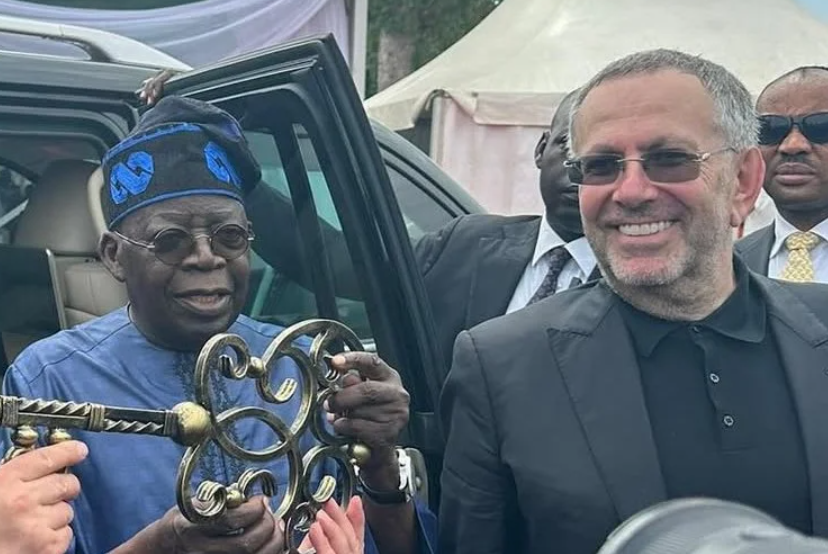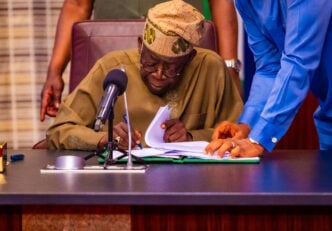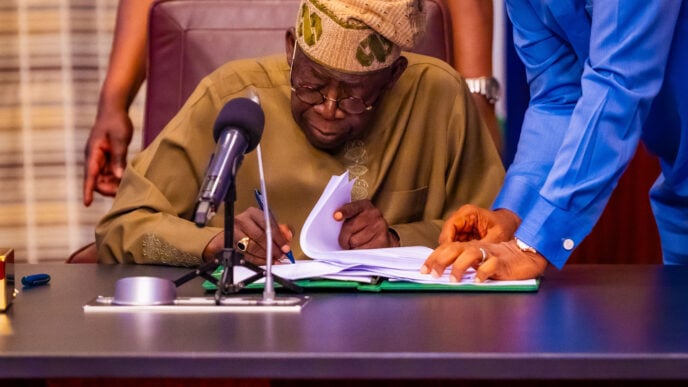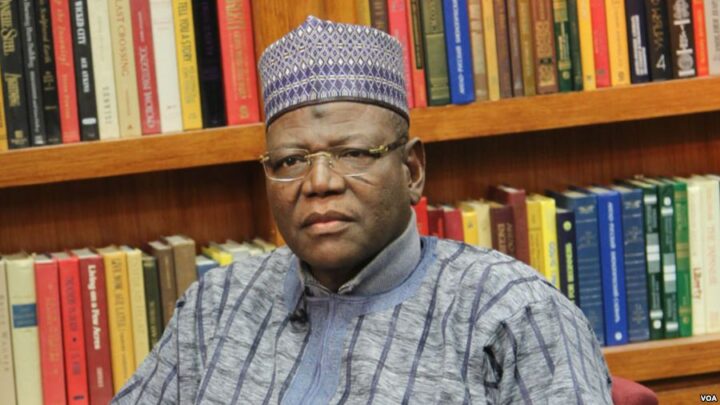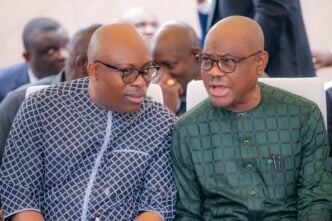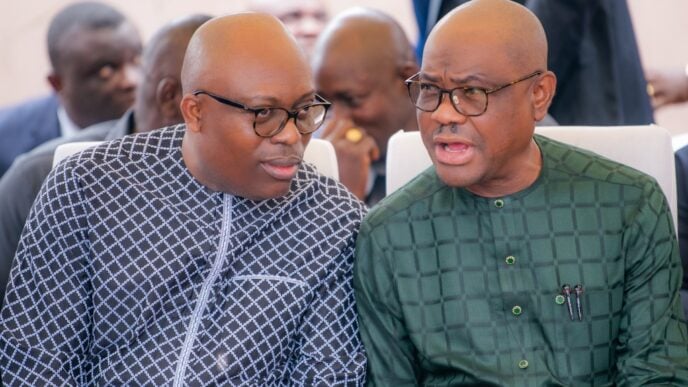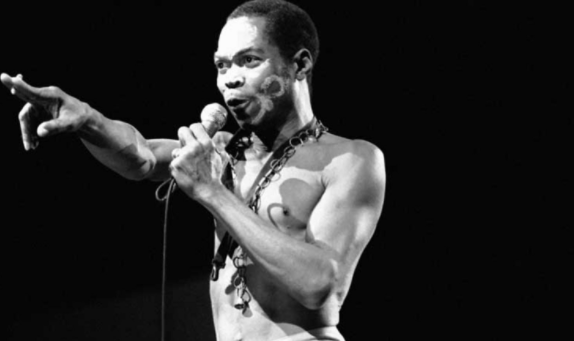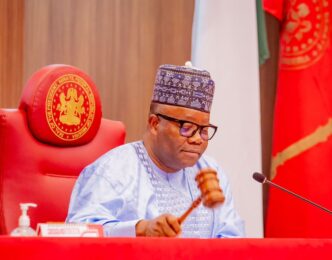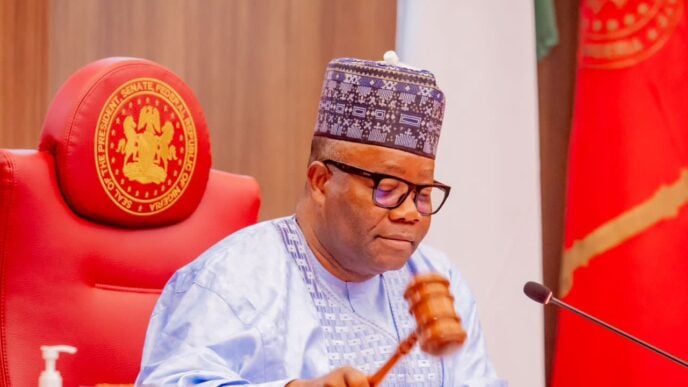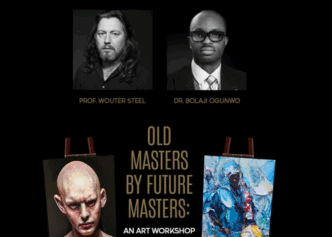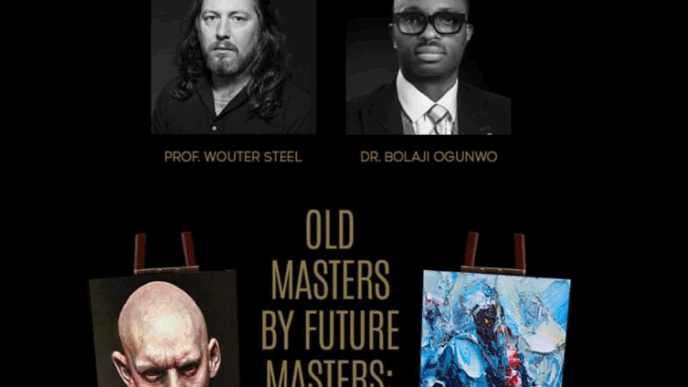Bola Tinubu and Alex Zingman
Last Monday, as noiselessly as a phantom, President Bola Tinubu brought home his strange friend. While an Igbo proverb says the footsteps of a man cannot create a stampede, Alexander Zingman, the president’s Belarusian friend’s sloppy footsteps created more than a stampede. It was as though the great South African poet Mazisi Kunene’s lines were being chanted to scare us. They reverberated round the length and breadth of Nigeria. “The madman has entered our house with violence/Defiling our sacred grounds/…Bending down our high priests with iron…” Kunene wrote. We could have kept silent at the appearance of the man who entered our own house. It should be the high priest’s wahala that a stranger could bend him so shamelessly. After all, Yoruba say, a mother who gives birth to a demonic child (omo òràn) has the sole burden of backing her imp.
In Abuja, at the official inauguration of 2000 tractors for distribution nationwide by his administration, Tinubu openly acknowledged the contractor who handled the tractor purchase, Zingman, as his former schoolmate at the Chicago State University (CSU). “Alex was my very good neighbour and schoolmate in Chicago. Never did we dream that I would become President of the Federal Republic of Nigeria and Alex, a successful businessman from Belarus, working together to promote the prosperity of our two countries. I believe our university will be very proud that we are doing this here today,” he said.
Oh, Chicago, again!
By the way, you don’t know the Ìkéèmù? You probably then wouldn’t know the Afó’kéèmù. The Ìkéèmù is one of the relics of traditional Yoruba society that didn’t survive into the now. Its most relatable equivalent is Western society’s pitcher. Ìkéèmù is a broken pottery crushed and reused into a container for drawing water from the pot. However, while the pitcher has a lip or spout and a handle, the Ìkéèmù doesn’t. Virtually all homes which owned a central clay pot, reputed to be an ancient water cooling technology, had the Ìkéèmù for drawing its water. Many epigrammatic imagery got made to support this African pitcher. Two of such were projected in two songs of Yoruba Apala music singer, Ayinla Omowura. One was in an elegy to the fallen Nigerian Head of State, General Murtala Muhammed and the other, a tribute to Shuaib Ayinde Bakare, a Juju musician who was murdered on October 1, 1972. Muhammed had fallen to the irreverent bullets of Colonel Bukar Suka Dimka and his coup plotters on February 13, 1976.
Advertisement
In a tear-inducing dirge garnished with Abeokuta, Egba dialect, Omowura mourned Muhammed with an infectious solemnity.“General, (Balogun) fare thee well,” he sang. “We can only meet when we chance into your lookalike or in a dream. Even one on horseback cannot now outpace you in your race to the hereafter.” The musician then veered into lamentation. Wickedness had taken over the face of the earth, he wailed. It had so flourished that the wicked (Ìkà) never wish that the one who shoulders a heavy load ever gets respite from their heavy laden. Regardless of their wishes, however, sang Omowura, one’s destiny (orí) will always intervene. Now deploying the Ìkéèmù imagery to ram home his message, Omowura wondered why the world is so implacable that, the normal routine of fetching water to drink from the pot with the Ìkéèmù and dropping it on the pot’s small lid at the completion of the task, attracts the world’s frown. “Ayé ò fé ká mu’mi, k’á sò’kéèmù sí’lè, l’ayé fi ńjo mí l’ójú”, he lamented. Omowura compared General Muhammed’s gruelling fate in the hands of unknown assailants to the above fate of this traditional pitcher, the Ìkéèmù.
The singer was not done with the pitcher imagery. In an earlier immediate post-civil war album he did, rather than use the Ìkéèmù, Omowura chose to deploy the same image of a cup, with a different but deeper name, “Ìmumi.” At the murder of his musical contemporary, Ayinde Bakare, Omowura did another very moving elegy for this Lafiaji, Lagos-born, talented musician. Murdered by a God-knows-who, Bakare’s headless corpse was discovered by the Lagos State government inside the lagoon after days of search. He was subsequently given an anonymous burial by the state. However, his name, ‘Bakare’, inscribed on his arm at birth, alerted the search party when it stumbled on it inside the government’s hospital file. Bakare’s remains were eventually exhumed and properly reburied by his contemporaries like Sunny Ade, Ebenezer Obey, IK Dairo and Adeolu Akinsanya, alias Baba Ètò. In his elegy to the departed Bakare, Omowura also wondered why the people of the world always want to break one’s pitcher, an imagery for existence. He sang this as, “Ìmumi èdá l’ayé ńfé fó…” He, however, besought God never to allow them.
Around Ìkéèmù were conjured many other epigrammatic myths, lore, wise sayings and practices. For instance, woe betides the child who breaks this traditional pitcher. On top of being demonized for this malfeasance, the pitcher-breaker is continuously made the butt of inelegant descriptions at home. No matter how long after the Ìkéèmù had been broken, the ‘sin’ of the child’s temerity of breaking the family pitcher is exhumed and referenced, either in momentary jokes, for attribution or as reminder of how not to maltreat family property. The ceaseless reference to this pitcher-breaking infraction birthed the aphorism, “Enu kìí sìn l’ára afó’kéèmù . The most similar repetitive conjuration of the sin of the breaker of the pitcher can be found in Wole Soyinka or John Pepper Clark’s Abiku poems. They both treat the concept of irritating repetition. For Soyinka, the resembling line is, “I am Abiku, calling for the first/And repeated time” while Pepper-Clark’s is “Coming and going these several seasons/Do you stay on baobab tree?” The two poems are both dismissive of the Yoruba Abiku mythical child who is possessed by the stubborn spirit of dying and rebirth in its mother’s womb, in a continuous process.
Advertisement
The greatest calamity that could befall a communication team of a politically exposed person is to have a flippant boss. Immediately after his unconscionable remark at the commissioning of the 2000 tractors, Tinubu’s communication team must have been hit by a seismic upheaval equivalent in proportion to the Hiroshima and Nagazaki bomb. At that event, apparently feeling the need to bolster the narrative that he indeed possessed the highly-disputed CSU certificate, Tinubu flippantly descended into a needless Zingman narrative. In the process, he did his disputatious certificate reputation another fatal blow.
In 2023, in an operation similar to Donald Trump’s Midnight Hammer strikes on Iran, fearless Nigerian journalist, David Hundeyin, bombed Tinubu’s nuclear sites bunker. The bunker was where he hid the facts and fictions of his CSU certificate. Hundeyin bombed Tinubu’s bunkers with equivalents of America’s B-2 bombers and cruise missiles. His aim was to penetrate the secrets therein. Thereafter, all went quiet on the home front as the Tinubu camp claimed the bombers merely scratched the surface of his nukes. However, last week, the president’s penchant for superlatives exhumed the Chicago certificate corpse buried in a shallow grave. His self-thrown bomb hit his guarded nukes’ sight. By this, the president and his certificate, the latter of which has been in the news since 2000 when the scandal broke, became the centre of discourse again. This is making it the proverbial pitcher-breaker, the Afo’kéèmù, whose sin is the subject of repeated innuendos, mockeries and discussions.
Doubtless, we live in a world that reggae music superstar Bob Marley described as “light as feather and heavy as lead”. Immediately the president mentioned Zingman as his friend, national curiosity over this strange man inflated like a penny balloon. Zingman’s dossier became a hot search sport. In a jiffy, his resume was on the radar, and his details landed in the palms of every Nigerian. In May 2023, Kenyans were similarly upbeat about Zingman. This was when his name was announced in the delegation of the country’s minister of commerce’s visit to Qatar. He and another Belarusian buddy of his, Oleg Vodchits, were listed as “advisers for the Gulf countries” to the Kenyan minister’s event. Aged 56 in 2023, Vodchits was 36 at the time. More than this, Kenyans’ checks revealed that the duo had earlier been detained for two weeks in the DR Congo on the allegation of ties with war veteran, Joseph Kabila.
Other information revealed that Zingman had close ties to Belarusian President Alexander Lukashenko, one of the most despotic leaders in Europe. Through this tie, he strikes quid pro quo deals with the tremendous backing of Lukashenko. After a state visit by Lukashenko, Zingman once landed a $66 million contract in Zimbabwe for the supply of about 3,500 tractors. Vodchits, his ally’s photo-op with the Zambian president, with both men holding wine glasses in a scintillating manner, drew flak from Zambians. This was after investigations revealed that official corruption deals might have been the twine binding them together. Reports also had it that Zingman has close ties to top officials in about a dozen African and Middle Eastern countries. When the Pandora Papers were released on October 3, 2021, by the International Consortium of Investigative Journalists (ICIJ), Zingman’s name was linked to documents which alleged that he and an unnamed partner had made use of offshore shell companies to hide their interests in a Zimbabwean gold deal.
Advertisement
In the national frenzy to situate Tinubu’s most recent strange friend, respected online newspaper, TheCable’s Fact Check burst the bubble. Its forensic scan put a lie to the president’s claim that “Alex was my very good neighbour and schoolmate in Chicago.” Born on November 26, 1966, in Minsk, Belarus, not only will Zingman be 59 years old by November 2025, but he attended University of Illinois, Chicago (UIC), United States, from 1991 to 1995, two decades after the president left university. More instructively, while Zingman attended UIC, Tinubu claimed he attended the CSU in 1979. So, why did Tinubu conflate the universities? Was this a deliberate lie, misrepresentation, falsification of fact or fabrication of relationship, what Yoruba call “tan’ná w’ébí”? What ulterior motive was that lie put to? Was the president genuinely misled about Zingman, or was the untruth made in the quest to further make the corpse of his CSU claim walk? Or, is the president suffering from momentary amnesia? Or, is such barefaced lying the way of life of the man who is our president? The whole Zingman episode stinks and, in the words of Olatunji Dare, gets “curiouser and curiouser”.
If you saw how fluidly Zingman genuflected on that day, smiling from ear to ear like a lost tabby, your hunch should tell you that something was just not right. As Tinubu bathed him with unearned encomiums, the Belarusian twiddled his frame like a tadpole which my people call légbénlègbé. Anyone familiar with the dramatics of Smart Alecs would see something similar in the Belarusian’s mannerism. My take is that Alec has spent considerable time studying the psyche of African leaders. He found out that grovelling, pandering to their vanity, is the key that unlocks their country’s vaults. It is opaque characters, with heavy roaches in their wardrobes, that African leaders find convenient to deal with. Another hunch I have is that Zingman, hunting for scandals as a ladder into the hearts of African leaders, found Tinubu’s Achilles heel to be that he needed foreign validation for his unending Afó’kéèmù Chicago University scandal. Smart Alec then opted to feed the president the bait of his attendance of the same university with him. The president would be just too eager to award a multi-million-dollar contract to a fawner.
The need for interrogation of this obvious ad-lib presidential lie got further compounded. TheCable Fact Check’s methodic drilling then revealed that not only didn’t both men – Tinubu and Zingman – ever attend the same university, the period of their attendance was decades apart. Zingman must have been about eleven years old at the time Tinubu enrolled at the CSI in 1977, and age 13 at the time of his graduation. Zingman’s profile even further indicated that he hadn’t moved to the US as at the time Tinubu was a student of CSU.
Nigerians should be genuinely bothered about Tinubu’s new strange friend. Such serpentine associations raise questions about the boundaries between personal and public interests. Tinubu is, however, not alone in the acquisition of questionable friends and associates. Slovak Prime Minister Robert Fico’s relationship with Marian Kocner similarly raised eyebrows. The question on the lips of Slovanians was why Fico would get involved with Kocner, a businessman notorious for several high-profile corruption scandals. Fico’s government was embroiled in scalding criticisms over its handling of corruption cases, with his relationship with Kocner as a bad advertisement. The same moral measure was used to weigh former Ukrainian president Viktor Yanukovych’s relationship with Oleksandr Yanukovych. Yanukovych’s son, Oleksandr’s had already acquired a notorious renown for living a lavish lifestyle and was implicated in several corruption scandals. These examples not only illustrate the complex tar-brushing relationships that could exist between world leaders and their associates, but they often point at off-the-table dubious deals.
Advertisement
An ancient English aphorism argues that, when you show me your friend, I will tell you who you are. When the Nigerian president has as a friend a Zingman, with such a disputatious past and present, it tells onlookers not to look too far to see who he himself is. The Zingman pattern of sidling into African presidents was replayed prior to now. First Lady, Oluremi Tinubu, had reportedly visited Lukashenko on a shuttle diplomacy in 2023 to express appreciation to the Belarusian president for scholarships awarded to Nigerian students on her “Renewed Hope Initiative” programme. Thereafter, the contract, running into millions of dollars, was awarded to Zingman’s firm for the supply of 2,000 tractors.
My advice to our president is to heed the imperishable advice of American performer, actor and humorous social commentator, William Rogers (November 4, 1879 – August 15, 1935). Rogers’ words to him are: “When you find yourself in a hole, quit digging.” It is obvious that, on the matter of his CSU certificate, against Rogers’ counsel, the president is trapped inside a deep trench and is yet digging. It not only makes him susceptible to unconscionable scammers, makes him vulnerable to baits, the type he just swallowed, it ensures he is vulnerable in all material particular.
Advertisement
The three wrongs of Owo Memorial Park’s demolition
The furore over the recently pulled down Owo Memorial Park in Ondo state is said to have thawed, which is gladsome. There is, however, a need to further examine the subsisting issues in the drama. The park, constructed by the late governor of the state, Rotimi Akeredolu, in honour of victims of a terrorist attack that occurred on June 5, 2022 at St. Francis Catholic Church, Owo, with casualties of over 40 people, was dismantled by the current governor, Lucky Aiyedatiwa. At the hub of the crisis was the park’s location opposite the Olowo of Owo’s palace. Ever since its dismantling, it has generated such hoopla at the centre of which was the wife of the late governor, Betty, the Ondo state government and the Owo palace. While Mrs. Akeredolu believes the pulling down of the park was a continuation of perceived acrimony of Aiyedatiwa against her husband, the government maintained that it merely hearkened to the call of the Owo palace to respect tradition and pull down the “offending” park.
Advertisement
Rather than a clash of culture and religion that many see in the tiff, I tend to see arrogance of position on the sides of the three parties. Whipping up sentiments and emotions in a video she posted on her X page, Betty wrote, “Darling, I’ve always known you to love your people. See what they’ve done to you. They didn’t blink an eye in rubbishing your memory and legacy. Spearheaded by the Olowo of Owo, whom you single-handedly installed, and ‘Lucky’, the enabler, ordered the demolition of a monument built to remember those massacred. Nobody was buried there — it was symbolic. They travel abroad and see how memorials are treated with respect. Why do we do things differently? To score political points? The Oba that doesn’t want the so-called cemetery — but it’s not a cemetery — sleeps with the dead. All the Olowos were buried where he lived. Look at the hypocrisy! So long as I live, they will not succeed. They will not rubbish you. Aketi lives on.”
You may not be able to stand the face of Betty, especially her constant veers into ethnic slants, but that post is replete with a lot of sense. Promptly, the Olowo-in-Council issued a statement which stated that the palace was taking responsibility for the demolition as it personally urged the government to demolish the park due to its affront against Owo’s long-held culture. To underscore its enjoyment of an Owo-wide acceptance, a group of protesters recently openly affirmed that the decision was done in the interest of Owo culture. The palace statement said, “It must be made clear that the decision to site the structure in that particular location was resisted by the Olowo-in-Council and frowned upon by the people of the community when it was being conceived by the government of the late Governor, Arakunrin Rotimi Akeredolu.” The palace then thanked the “listening” Governor Aiyedatiwa for acceding to its request.
Advertisement
The tripodal blame on all parties goes thus: One, the question to be posed to the palace is, if the “unlistening” Governor Akeredolu hadn’t passed on, what would have happened to the park? If nothing happened to Owo for almost three years of the construction of the park, why is the palace mythifying culture by claiming that the erection of memorial parks is a palace taboo? Again, which parks had been constructed close to the palace before now, so that we can know their negative effects? If none, how come the palace still holds on to it as a taboo? How many taboos of the ancient past have been moderated in the face of modernity, or does the palace observe all of them till today, hook, line and sinker?
Lastly, the other question to ask is, is culture made for man or man was made for culture? No one needs to tell anyone that Owo needs to memorialise that gory event of June 2022 when some misbegotten blood-seeking vampires killed worshipers in one fell swoop. Akeredolu did well by constructing the park so that the memories of the dead would be kept alive and Owo itself would be reminded to be on its guard against repeat occurrences. More importantly, why didn’t the palace ask the government to demolish all the infrastructure that Akeredolu constructed in Owo, since it is so rankled by the late governor’s footprints? These questions needed to be answered, and sincerely too so that some people seeking to even scores won’t hide under a nebulous culture they created.
For Mrs. Akeredolu, having lived for decades in Yorubaland, she should have realised that Yoruba revere their culture. They won’t even stand an outsider making a mockery of it. Using foul words on the monarchy of Owo, especially when her children, bona fide children of Owo, would forever need the ancient town for, especially, validation all the days of their lives, is akin to destroying their future.
While the Ondo state governor must be commended for promptly acceding to the request of the palace, Ondo people would be more excited if the government deploys the same alacrity it took to dismantle the Akeredolu-built park to finish the many projects the governor’s late boss began but which death prevented him from concluding. Hiding under the banner of “palace request” to execute a governmental philosophy is mean.
Views expressed by contributors are strictly personal and not of TheCable.
